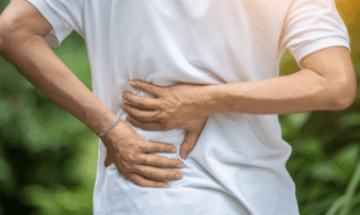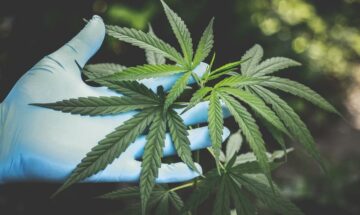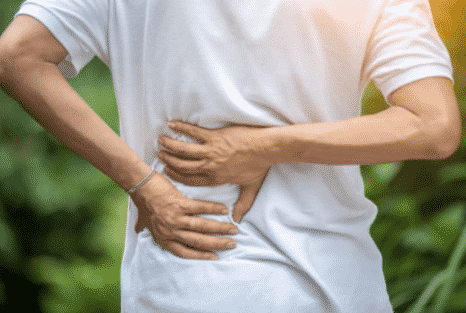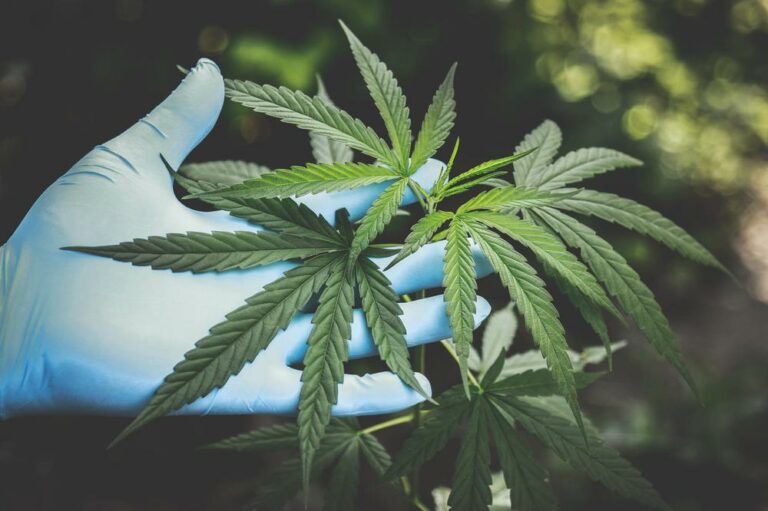
Are you searching for a natural alternative for muscle relief? Read on and find out how CBD muscle balm may help promote wellness and relieve muscle aches and pains.
Are CBD balms beneficial for muscle relief, and if so, how? Are there risks in using CBD muscle balms?
-
- Muscle balms are topicals typically used for targeted relief. Remedies for muscle injuries also help alleviate pain, reduce inflammation, and minimize further muscle damage(1).
-
- In the 2016 study, no adverse effects were observed when CBD was given to the animal models. CBD has an excellent safety profile(3).
-
- CBD topicals, like muscle balms, have low skin penetration(4). When topically applied, CBD does not enter the bloodstream.
-
- CBD is also non-psychoactive(5), so users do not get high. Still, always consult with a doctor before using CBD muscle balms.
What Are CBD Muscle Balms?
CBD muscle balms are classified as CBD topicals. These muscle balms are products infused with cannabidiol (CBD).
CBD topicals are preparations that are directly applied to the skin. Aside from balms, other CBD topical products include topical CBD cream, oils, serums, roll-ons, CBD lotions, ointments, pain creams, and salves.
CBD balms are often confused with CBD salves. These two product formats are traditionally made from combined fatty and essential oils, wax, and CBD.
Compared with balms, salves are generally softer. When applied to the skin, salves may penetrate the skin deeper. Balms stay on top of the skin.
In terms of consistency, balms are thicker than salves, so users need to apply more pressure when rubbing balms to the skin. Individuals with sore muscles may find the application of balms therapeutic.
Some CBD topicals may contain moisturizing and natural ingredients, like shea butter, cocoa butter, beeswax, aloe vera, coconut oil, blood orange oil, lavender oil, vitamin E, and flower extracts.
Other topicals, particularly those formulated for pain relief, contain peppermint oil, wintergreen oil, menthol, camphor, and arnica. These ingredients induce a cooling sensation in users.
CBD muscle balms may also help alleviate muscle soreness, joint pain, and other related conditions.
A mouse study has found that CBD has analgesic (pain-relieving) and anti-inflammatory properties(6). These benefits may be helpful in muscle pain relief during a patient’s recovery time.
Typical ingredients used in CBD products for muscle relief include MSM, hemp extract, phenoxyethanol, caprylyl glycol, sorbic acid, carbomer, purified water, and isopropyl alcohol.
These CBD products also contain muscle-soothing ingredients, such as eucalyptus and camphor, and oils, such as tea tree oil, lemon balm leaf oil, and jojoba seed oil.
CBD topical creams and muscle rubs may also be used for an individual’s pre-workout regimen or during their post-workout recovery.
However, professional athletes should be cautious when using certain CBD products. Some formulations contain trace amounts of tetrahydrocannabinol (THC), which may be detected in some drug tests.
THC, the active ingredient predominantly found in marijuana plants, has psychoactive effects. Meanwhile, CBD is nonpsychoactive(7).
Why Use CBD Muscle Balms?
Studies have shown that CBD products, such as muscle balms, may be beneficial in treating pain, inflammation, muscular dystrophy, and other ailments associated with these conditions.
Muscular dystrophy is a collective term for diseases that cause progressive weakness and gradual loss of muscle mass(8).
CBD topicals may be useful for sore muscles, back pain, inflamed joints and muscles, bruised or painful body parts, insect bites, acne, and skin ailments, such as eczema.
A 2018 study revealed that the most common medical condition for which CBD is used is pain(9).
Another study also conducted in 2018 reported that pain and inflammation are caused by the body’s response to infections, tissue injuries, and genetic changes. The researchers said that pain has two phases: acute and chronic pain(10).
A specific injury or disease may cause both acute and chronic pain. However, chronic pain exceeds the “normal time of healing” compared to acute pain(11).
Chronic pain may come from psychological states and has “no recognizable end-point(12)” but can be treated with multimodal therapies over time.
CBD for Pain and Inflammation
According to research published in the journal Future Medicinal Chemistry, the manipulation of endocannabinoids and the use of cannabinoids might have therapeutic effects in inflammatory conditions(13).
Cannabinoids are substances that interact with the endocannabinoid system (ECS). They may come from the body, be derived from laboratories, or extracted from Cannabis sativa.
CBD is a phytocannabinoid that comes from the cannabis plant(14).
Cannabinoids help the ECS regulate body functions, such as pain responses, memory, appetite, and mood(15).
A 2018 study published in the journal Molecules reported that CBD might help reduce inflammation and block pain in acute and chronic pain models(16).
The authors of the study suggested that CBD’s analgesic and anti-inflammatory properties might have caused these therapeutic benefits.
The researchers also revealed that the combination of CBD with THC and the other components of the cannabis plant, like flavonoids and terpenoids, might have a synergistic effect on pain treatment.
CBD for Chronic Pain
A 2018 study published in the journal Frontiers in Pharmacology suggested that cannabinoids might be more effective in treating chronic pain than acute pain(17).
A study published in the British Journal of Pharmacology stated that CBD might be promising in the treatment of chronic pain associated with diseases(18).
Another study in 2015 reported that cannabinoids might be useful in treating chronic pain and spasticity(19).
Johns Hopkins describes spasticity as abnormal muscle tightness caused by prolonged muscle contractions(20).
CBD for Neuropathic Pain
According to Mayo Clinic, peripheral neuropathy is caused by damage to the nerves outside the brain and spinal cord. It results in pain, weakness, and numbness in the hands, feet, and other parts of the body(21).
Currently, no cure has been found to reverse neuropathic pain. Treatments can only reduce their symptoms(22).
A recent study in 2020 revealed that the application of CBD oil transdermally might cause significant improvements in pain experienced by peripheral neuropathy patients(23).
The authors of the study also suggested that CBD oil might be a more effective alternative than current peripheral neuropathy treatments. Further research is needed to compare potential benefits.
Another study outlined the clinical trials that reported the therapeutic promise of CBD and THC in treating neuropathic, inflammatory, and oncologic pain(24).
CBD for Arthritis
Arthritis is characterized by swelling of joints. The most common arthritis types are osteoarthritis and rheumatoid arthritis(25).
A 2016 study conducted in rodents revealed that CBD applied to the skin might have therapeutic benefits on arthritis inflammation and pain-related behaviors(26).
The researchers also found that administration of the transdermal CBD gel reduced joint swelling without causing adverse effects on the test subjects.
Another study that was also conducted in mice has found that transdermal CBD might be used as a potential anti-inflammatory treatment. The authors have found that CBD permeated the skin through the use of ethosomes(27).
Ethosomes are delivery carriers that help drugs reach deep skin layers or the body’s systemic circulation(28).
The results of these animal studies may be useful in further studies to be conducted on humans.
CBD for Muscular Dystrophy
A study in 2019 examined the effects of CBD and cannabidivarin (CBDV) on the muscle quality and performance of mice with Duchenne muscular dystrophy (DMD)(29).
CBDV is another nonpsychoactive cannabinoid that comes from the cannabis plant.
The researchers found that the use of CBD and CBDV on the test subjects reduced inflammation and impaired autophagy.
They concluded that these cannabinoids should be further studied because of their therapeutic promise in treating DMD and other muscular dystrophies.
Autophagy is a process that involves the cell breaking down and destroying damaged, abnormal, and old proteins and substances inside the cell(30).
CBD for Muscle Recovery
The external use of CBD muscle rubs and balms may be therapeutic in an individual’s muscle recovery.
Intense workouts may cause microscopic damage to muscle fibers(31). New workout routines may also lead to delayed body soreness that may persist for four to five days.
This soreness is known as delayed onset muscle soreness (DOMS). It is different from other forms of muscle pain.
DOMS is a symptom of exercise-induced muscle damage (EIMD). This muscle damage is common to individuals who suddenly do vigorous sets of exercises that their body is not accustomed to(32).
According to a study, nonsteroidal anti-inflammatory drugs (NSAIDs) are often prescribed to help in the post-workout recovery process of those with EIMD(33).
The study also found that occasional use of NSAIDs does not affect muscle growth. However, long-term NSAID use could be detrimental to those with excellent muscle growth potential(34).
According to a study evaluating Sativex’s effects, CBD has muscle relaxant properties(35). This benefit may be useful to patients who have muscle pain conditions.
Sativex is a mouth spray with CBD and THC as its primary ingredients. It is used to treat symptoms of multiple sclerosis and muscle stiffness (spasticity).
How CBD Muscle Balms Work
The ECS has cannabinoid (CB) receptors found on the skin, particularly cannabinoid receptor 1 and cannabinoid receptor 2(36).
These cannabinoid receptors may be targeted by cannabinoids to help relieve pain and inflammation.
A 2017 study detailed the essential role of CB1 receptors in regulating pain(37). The CB1 receptor is the primary receptor of the central nervous system, which is responsible for pain regulation(38).
According to the study, CB2 receptors are possible targets for the treatment of inflammatory pain. These receptors are densely expressed in immune system cells.
Another study in 2018 stated that CBD’s analgesic properties were caused by CBD’s action as an agonist for receptors associated with anti-inflammatory activity(39).
Agonists are drugs or chemicals that bind to receptors and activate them to produce the same action as the substances that typically bind to these receptors(40).
The Pros and Cons of Using CBD Muscle Balms
The Pros
-
- Topical CBD products, such as CBD muscle balms, may provide targeted relief for specific conditions. They may be applied to the body parts affected by pain.
-
- CBD is non-psychoactive(41). It does not cause a high in users. The topical application of muscle balms also ensures that CBD does not enter the bloodstream.
-
- CBD muscle balms are topically applied and not ingested. For this reason, first-time CBD users and individuals who dislike CBD’s grassy flavor do not have to worry about CBD’s taste.
-
- CBD muscle balms are easy to use. They can also be conveniently brought anywhere, especially when traveling.
-
- Topical CBD products, like CBD muscle balms, are combined with natural ingredients that may be beneficial for skin care and may have moisturizing benefits.
The Cons
-
- It is more challenging to find an accurate, effective, and consistent dosage when using topicals, such as CBD muscle balms. The United States Food and Drug Administration (US FDA) has approved CBD use only in the treatment of epilepsy(42). Hence, there is no standard CBD dosage chart.
-
- CBD may have drug interactions with medications broken down by cytochrome p450 liver enzymes(43). Consumers who use prescription medications should first consult with a doctor.
-
- The therapeutic promise of CBD muscle balms is limited to the areas where CBD can be applied topically. They cannot be used to treat psychological disorders, such as depression and anxiety.
-
- CBD topicals have low skin penetration(44). Hence, results may not be observed instantaneously.
-
- CBD muscle balms are not cheap. Prices range from $25 to $82, with varying balm sizes and CBD concentrations in each product. For instance, a 50-ml balm with 50-mg CBD could cost $25 while a 60-ml balm with 800-mg CBD could cost $82.
How CBD Muscle Balms Compare to Alternative Muscle Pain Treatments
White Willow Bark
According to a study, one of the oldest herbs used in treating pain and inflammation is the bark from the white willow tree(45).
The study compared white willow bark to aspirin, an NSAID. It concluded that the herb and the drug had a similar anti-inflammatory mechanism of action.
The researchers of the study also reported that white willow bark had fewer side effects compared with aspirin. However, the herb is costlier than aspirin.
It should not be used in children and other individuals with certain conditions, like diabetes and peptic ulcer disease. Always consult a licensed professional for health concerns.
Curcumin
Another alternative treatment for inflammation is curcumin. It is a yellow pigment in turmeric, a flowering plant of the ginger family(46).
Research published in the journal Surgical Neurology International has found that curcumin has antioxidant and anti-inflammatory properties. These benefits make it a promising natural alternative to NSAIDs for inflammation treatment(47).
The authors of the study noted that the side effects of curcumin are few. However, prolonged use can result in upset stomach and gastric ulcers.
The researchers also cautioned that curcumin might have drug interactions with anticoagulant medications and high doses of NSAIDs.
Arnica
A study published in the journal Advances in Therapy has shown that arnica gel and ibuprofen, an NSAID, had the same efficacy in treating osteoarthritis(48). The researchers noted that the use of arnica gel had minimal side effects.
The authors also cited another study on the administration of arnica gel to patients with knee arthritis.
The researchers revealed that the test subjects experienced marked reductions in pain and stiffness and observed improvements in their knee function.
Arnica comes from Arnica montana flower extracts. It is one of the commonly used medications in treating pathological conditions, like pain, swelling, stiffness, and osteoarthritis(49).
CBD’s side effects include appetite and weight changes, tiredness, and diarrhea(50). Compared with that of NSAIDs, CBD’s side effects are minimal.
NSAID side effects include the following(51):
-
- Gas
-
- Bloating
-
- Heartburn
-
- Nausea
-
- Stomach pain
-
- Diarrhea or constipation
-
- Vomiting
-
- Lightheadedness
-
- Dizziness
-
- Difficulty balancing
-
- Concentration problems
-
- Mild headaches
Studies have shown that CBD has benefits beyond its anti-inflammatory and analgesic properties compared with the natural alternatives cited previously.
CBD for Stress
According to the American Psychological Association, stress is related to muscle tension. When an individual is stressed, the muscles become tense(52).
A 2015 study revealed that CBD might reduce the behavioral and physiological signs of stress.
In the study, the researchers observed that the heart rate of the test subjects normalized when they were administered CBD(53).
CBD for Enhanced Sleep
In a 2014 study published in The Journal of Pain, the official journal of the American Pain Society, researchers concluded that sleep disturbances might inhibit essential processes that help in the maintenance of chronic pain, such as endogenous pain inhibition(54).
A 2019 study found that sleep and the test subjects’ anxiety symptoms significantly improved when they were administered CBD(55).
Another study published in the Journal of Psychopharmacology reported an observed increase in the total sleep time of the test subjects who were given CBD(56).
Researchers also found that CBD might be useful in improving insomnia(57).
How to Choose the Right CBD Muscle Balm
In choosing the best CBD topicals, consumers should primarily look for a product’s potency. Whether a consumer is looking for the best CBD cream or the best CBD muscle balm, product potency is essential.
As mentioned by a study, topically applied CBD does not penetrate the skin easily. Hence, potent products are required to yield positive results.
The concentration of potent products ranges from 200 mg of CBD to 3,000 mg of CBD.
When choosing CBD muscle balms, people should also check if they are full-spectrum CBD, broad-spectrum CBD, or CBD isolates.
Full-spectrum CBD uses all the components of the cannabis plant, including less than 0.30% THC, flavonoids, terpenes, and fatty acids.
Experienced CBD users are more likely to get full-spectrum products because they are believed to be more therapeutic.
Using all of Cannabis sativa’s components produces a synergistic effect, known as the entourage effect. This mechanism is suggested to make full-spectrum products more effective when used in the treatment of several conditions.
However, since full-spectrum products contain trace amounts of THC, these may be detected by some drug tests.
For professional athletes and people who want to avoid drug test risks, broad-spectrum muscle balms are recommended.
Broad-spectrum products have the same components as full-spectrum products, except for THC.
Meanwhile, consumers who want to use pure cannabidiol, without terpenes and other ingredients, may purchase CBD isolates.
Purchase CBD muscle balm brands from credible manufacturers that have quality control procedures in place.
Excellent brands have the following information available on their website:
-
- Source of industrial hemp used in the CBD product – High-quality products are made from US-grown, certified organic, and non-GMO hemp plants. The US has stringent cannabis agricultural regulations.
-
- Certificate of analysis – This is a document from accredited laboratories that provides a breakdown of the product’s composition.
-
- Third-party reports – They certify that product is free from pesticides, molds, and heavy metals.
-
- User reviews – There is merit when consumers check out feedback online.
In choosing CBD muscle balms, consumers should opt for products that are all-natural and made from organic ingredients. Some muscle balms are even vegan, making them more eco-friendly.
How to Use CBD Muscle Balms
In using CBD muscle balms, consumers should take note of the following steps:
-
- Before using the product, consumers should check the instructions and recommendations from the manufacturer.
-
- Identify areas of the body that need treatment.
-
- Wash hands to make sure the application procedure is sanitary.
-
- Clean and dry the affected area.
-
- Check for open wounds and cuts. Do not apply CBD on broken skin to avoid infection or further irritation of the skin condition.
-
- Estimate the amount of CBD muscle balm that may be needed.
-
- Apply the balm by massaging or rubbing on the skin in a circular motion.
-
- Avoid touching the eye as some CBD muscle balms have ingredients, like capsaicin, that may be irritating to the eye.
-
- Wait until the product takes effect. CBD topicals may take up to two hours before therapeutic effects are observed.
-
- Store muscle balms properly. Ensure that the lid is sealed tightly and stored in a cool, dry, and dark space.
-
- If therapeutic benefits are not felt, consumers may increase the dosage or change their CBD muscle balm to a stronger and more potent one.
-
- Write a review on the product’s website to help fellow CBD users choose a product that may work for them.
-
- Consult a health professional for any pain that is severe or not improving.
Other Ways to Take CBD
Aside from CBD topicals, like CBD muscle balms, there are other ways to consume CBD.
CBD may be taken orally through product formats like CBD capsules, CBD pills, CBD gel caps, CBD gummies, CBD oil, and CBD tinctures.
CBD tinctures may be taken sublingually (under the tongue). Meanwhile, CBD oils and capsules may be ingested or combined with food and beverages for easier administration.
CBD may also be inhaled via CBD vapes and CBD vape pens. When inhaled, CBD takes effect instantly. However, vaping may cause lung problems in some users(58).
The use of vape pens may also pose a challenge in maintaining a consistent CBD dosage and intake. The amount of CBD inhaled in each draw is difficult to determine.
Conclusion
CBD muscle balms may be helpful in the treatment of muscle pain and other associated conditions. CBD’s suggested anti-inflammatory and analgesic properties are therapeutic to individuals with muscle and joint pains.
Compared with traditionally used pain relief and anti-inflammatory medications, like NSAIDs, CBD has a more excellent safety profile.
Natural alternatives, such as the use of white willow bark, curcumin, and arnica, may be effective for ailments associated with inflammation and pain. However, CBD has properties that go beyond its anti-inflammatory and pain-relieving benefits.
CBD may help enhance sleep, which is related to pain. CBD may also reduce stress, which can cause muscle tension.
Compared with other CBD product formats, CBD topicals, such as CBD muscle balms, have low skin penetration.
Hence, frequent CBD applications for a consistent period of several weeks may increase the likelihood of consumers observing therapeutic benefits.
Significant research has been done on CBD’s suggested alleviating effects on muscle pain symptoms, such as inflammation. However, further research is needed on CBD’s therapeutic effects on muscle pain itself.
More research is also needed on whether CBD muscle balm is an effective post-workout supplement.
Before taking CBD for muscle pain relief or adding it to one’s post-workout regimen, individuals are advised to inform their doctors first and never self-diagnose or self-treat.
FAQs
1. How can CBD muscle balm help?
Human and animal studies show that CBD products may help relieve pain, inflammation, and muscular dystrophy(59-61). Muscular dystrophy refers to diseases that cause progressive weakness and loss of muscle mass(62).
A 2018 study reported that the most frequent medical condition for which cannabidiol is used is pain(63).
2. What evidence or research exists that CBD muscle balm helps?
Research shows that cannabidiol may have anti-inflammatory and analgesic properties(64-65).
CBD may help relieve arthritis inflammation and pain-related behaviors, according to an animal study(66). The researchers reported that the transdermal CBD gel reduced swelling.
A 2019 animal study showed that CBD and cannabidivarin (CBDV) reduced inflammation and improved muscle quality of mice with the genetic disorder known as Duchenne muscular dystrophy (DMD)(67).
CBDV, a cannabis-derived compound, is a nonpsychoactive cannabinoid like CBD.
The topical use of CBD muscle rubs and balms may provide therapeutic effects in muscle recovery. One study that evaluated Sativex’s effects reported that CBD has muscle relaxant properties(68).
Sativex is a mouth spray, with CBD and tetrahydrocannabinol (THC) as primary ingredients. Additional research is warranted to determine whether CBD muscle balms produce similar therapeutic effects.
3. Is there any evidence that CBD muscle balm is not beneficial?
In an animal study on the potential benefits of CBD on arthritis, researchers reported that topical CBD produced no adverse effects on the subjects’ skin(69).
CBD has a favorable safety profile(70). However, CBD topicals have low skin penetration(71).
Still, CBD is non-psychoactive(72). Thus, the compound does not get users “high.”
4. Will CBD muscle balm interact with any current medication I may be taking?
CBD may produce drug interactions with medications broken down by cytochrome p450 liver enzymes(73).
Cannabidiol may also cause interactions with drugs such as blood thinners(74). Blood thinners enhance blood flow through arteries and veins.
If you take prescription medications, consult with a doctor before using CBD products like CBD muscle balm.
5. Should I consider other treatments or products alongside CBD muscle balm?
You may use over-the-counter (OTC) and prescription pain relievers to treat muscle conditions(75).
Common OTC pain-relievers include Acetaminophen (Tylenol), which dulls pain receptors in the brain. Nonsteroidal anti-inflammatory drugs (NSAIDs), including ibuprofen (Advil), lower the production of hormone-like chemicals known as prostaglandins.
Meanwhile, prescription painkillers may provide relief for severe pain or chronic pain(76).
A consultation with your doctor regarding potential drug interactions is essential before using CBD muscle balm.
6. How much CBD muscle balm should I use?
Before using CBD muscle balms, review the manufacturer’s instructions and recommendations.
Estimate the quantity of CBD muscle balm that you may require. Apply a small amount of CBD topicals to the skin to determine whether it is well tolerated.
You may feel localized effects within ten minutes(77).
If you do not feel therapeutic benefits from CBD muscle balm, you may increase the dosage or use a product with a more robust potency.
Consult a healthcare professional for severe pain or pain that is not improving.
7. Are CBD muscle balms safe to use?
CBD products, such as CBD topicals, are generally well tolerated in humans(78).
Still, you may experience adverse effects such as rashes, skin, irritations, or allergic reactions from skincare products(79). Such side effects will likely cease after stopping cannabidiol applications or reducing CBD dosages.
If you experience such side effects after applying CBD topicals, consider consulting a dermatologist.
8. What are the potential side effects of CBD muscle balm?
CBD is generally well tolerated. Potential side effects include tiredness, dry mouth, appetite and weight changes, and diarrhea(80).
However, potential side effects of NSAIDs such as Advil may be more severe(81).
Other potential problems when taking CBD topicals include the purity and dosage of CBD products. A recent study of over 80 CBD products purchased online showed that over one-quarter of the products contained less CBD than what is indicated on the label(82).
9. Will CBD muscle balm make me high?
CBD is among at least 80 cannabis-derived compounds known as cannabinoids. Cannabidiol, unlike the cannabinoid THC, is non-psychoactive. Thus, it does not make people “high.”
Research suggests that CBD affects brain function and mood(83). However, unlike THC, CBD does not impair cognition or performance.
Hemp is the primary source of CBD products. These plants contain significantly lower levels of THC than marijuana plants.
10. Can I fail a drug test if I use CBD muscle balm?
The accumulation of THC from full-spectrum CBD may increase to detectable levels(84).
Thus, athletes, and individuals that want to avoid drug test risks, should consider broad-spectrum muscle balms.
Broad-spectrum CBD products contain a wide range of compounds like full-spectrum CBD. However, they are typically THC-free.
11. How does full-spectrum CBD balm differ from broad-spectrum CBD balm?
Full-spectrum muscle balms contain numerous compounds, including cannabinoids, flavonoids, terpenes, essential oils, and fatty acids.
Flavonoids are plant pigments, and terpenes are aromatic compounds. Essential oils are liquid plant extracts, and fatty acids are the building blocks of fat.
Broad-spectrum muscle balms also contain a wide array of cannabis-derived compounds. However, they are typically THC-free.
12. Is CBD balm allowed through airport security?
A majority of U.S. states have legalized medical marijuana(85). All other states have enacted laws allowing the use of CBD(86).
However, different states may impose restrictions on CBD products. They include ones related to the form of CBD, the amount of THC permitted, and the treatment of specific medical conditions(87).
The U.S. Transportation Security Administration (TSA) states that possessing cannabis-infused products, such as CBD oil is illegal under federal law unless they contain a maximum of 0.3% THC(88).
Another critical factor is whether a CBD product was derived from marijuana or hemp. In the 2018 Farm Act, the Food and Drug Administration (FDA) removed hemp with a maximum of 03% THC from its definition of marijuana(89).
13. What is the THC content of CBD muscle balm?
A CBD product’s THC content is dependent on the type of CBD. Full-spectrum CBD products contain a wide range of compounds, including up to 3% THC.
Broad-spectrum CBD products are typically THC-free.
CBD isolates typically contain no other cannabinoids besides cannabidiol.
14. What is the best way to apply CBD muscle balm?
Here are some basic guidelines for applying CBD muscle balm:
-
- Read the CBD product’s instructions and recommendations.
-
- Wash your hands. Clean and dry the affected area.
-
- Determine which body parts require treatment. Avoid applying CBD balms to broken skin.
-
- Massage or rub the balm into the skin using a circular motion.
-
- Wait a maximum of two hours for the CBD topicals to take effect.
-
- Avoid touching your eyes with the balm.
-
- Store the CBD balm properly.
- Baoge, L., Van Den Steen, E., Rimbaut, S., Philips, N., Witvrouw, E., Almqvist, K. F., Vanderstraeten, G., & Vanden Bossche, L. C. (2012). Treatment of skeletal muscle injury: a review. ISRN Orthopedics, 2012, 689012.
https://doi.org/10.5402/2012/689012 - Hammell, D. C., Zhang, L. P., Ma, F., Abshire, S. M., McIlwrath, S. L., Stinchcomb, A. L., & Westlund, K. N. (2016). Transdermal cannabidiol reduces inflammation and pain-related behaviours in a rat model of arthritis. European journal of pain (London, England), 20(6), 936–948.
https://doi.org/10.1002/ejp.818 - Iffland, K., & Grotenhermen, F. (2017). An Update on Safety and Side Effects of Cannabidiol: A Review of Clinical Data and Relevant Animal Studies. Cannabis and cannabinoid research, 2(1), 139–154.
https://doi.org/10.1089/can.2016.0034 - Bruni, N., Della Pepa, C., Oliaro-Bosso, S., Pessione, E., Gastaldi, D., & Dosio, F. (2018). Cannabinoid Delivery Systems for Pain and Inflammation Treatment. Molecules (Basel, Switzerland), 23(10), 2478.
https://doi.org/10.3390/molecules23102478 - Shannon, S., Lewis, N., Lee, H., & Hughes, S. (2019). Cannabidiol in Anxiety and Sleep: A Large Case Series. The Permanente Journal, 23, 18–041.
https://doi.org/10.7812/TPP/18-041 - Bruni, N. op. cit.
- Shannon, S. op. Cit.
- Mayo Clinic Staff. (2020, January 31). Muscular dystrophy. Retrieved from
https://www.mayoclinic.org/diseases-conditions/muscular-dystrophy/symptoms-causes/syc-20375388 - Corroon, J., & Phillips, J. A. (2018). A Cross-Sectional Study of Cannabidiol Users. Cannabis and cannabinoid research, 3(1), 152–161.
https://doi.org/10.1089/can.2018.0006 - Bruni, N. op. cit.
- Grichnik, K. P., & Ferrante, F. M. (1991). The difference between acute and chronic pain. The Mount Sinai journal of medicine, New York, 58(3), 217–220.
- Ibid.
- Nagarkatti, P., Pandey, R., Rieder, S. A., Hegde, V. L., & Nagarkatti, M. (2009). Cannabinoids as novel anti-inflammatory drugs. Future medicinal chemistry, 1(7), 1333–1349.
https://doi.org/10.4155/fmc.09.93 - Maroon, J., & Bost, J. (2018). Review of the neurological benefits of phytocannabinoids. Surgical neurology international, 9, 91.
https://doi.org/10.4103/sni.sni_45_18 - Human Endocannabinoid System. (n.d.). Retrieved from
https://www.uclahealth.org/cannabis/human-endocannabinoid-system - Bruni, N. op. cit.
- Vučković, S., Srebro, D., Vujović, K. S., Vučetić, Č., & Prostran, M. (2018). Cannabinoids and Pain: New Insights From Old Molecules. Frontiers in pharmacology, 9, 1259.
https://doi.org/10.3389/fphar.2018.01259 - Costa, B., Giagnoni, G., Franke, C., Trovato, A. E., & Colleoni, M. (2004). Vanilloid TRPV1 receptor mediates the antihyperalgesic effect of the nonpsychoactive cannabinoid, cannabidiol, in a rat model of acute inflammation. British journal of pharmacology, 143(2), 247–250.
https://doi.org/10.1038/sj.bjp.0705920 - Whiting, P. F., Wolff, R. F., Deshpande, S., Di Nisio, M., Duffy, S., Hernandez, A. V., Keurentjes, J. C., Lang, S., Misso, K., Ryder, S., Schmidlkofer, S., Westwood, M., & Kleijnen, J. (2015). Cannabinoids for Medical Use: A Systematic Review and Meta-analysis. JAMA, 313(24), 2456–2473.
https://doi.org/10.1001/jama.2015.6358 - Spasticity. (n.d.). Retrieved from
https://www.hopkinsmedicine.org/health/conditions-and-diseases/spasticity - Mayo Clinic Staff. (2019, May 22). Peripheral neuropathy. Retrieved from
https://www.mayoclinic.org/diseases-conditions/peripheral-neuropathy/symptoms-causes/syc-20352061 - Bruni, N. op. cit.
- Xu, D. H., Cullen, B. D., Tang, M., & Fang, Y. (2020). The Effectiveness of Topical Cannabidiol Oil in Symptomatic Relief of Peripheral Neuropathy of the Lower Extremities. Current pharmaceutical biotechnology, 21(5), 390–402.
https://doi.org/10.2174/1389201020666191202111534 - Manzanares, J., Julian, M., & Carrascosa, A. (2006). Role of the cannabinoid system in pain control and therapeutic implications for the management of acute and chronic pain episodes. Current Neuropharmacology, 4(3), 239–257.
https://doi.org/10.2174/157015906778019527 - Mayo Clinic Staff. (2019, July 19). Arthritis. Retrieved from
https://www.mayoclinic.org/diseases-conditions/arthritis/symptoms-causes/syc-20350772 - Hammell, D. C. op. cit.
- Lodzki, M., Godin, B., Rakou, L., Mechoulam, R., Gallily, R., & Touitou, E. (2003). Cannabidiol-transdermal delivery and anti-inflammatory effect in a murine model. Journal of controlled release: official journal of the Controlled Release Society, 93(3), 377–387.
https://doi.org/10.1016/j.jconrel.2003.09.001 - Verma, P., & Pathak, K. (2010). Therapeutic and cosmeceutical potential of ethosomes: An overview. Journal of advanced pharmaceutical technology & research, 1(3), 274–282.
https://doi.org/10.4103/0110-5558.72415 - Iannotti, F. A., Pagano, E., Moriello, A. S., Alvino, F. G., Sorrentino, N. C., D’Orsi, L., Gazzerro, E., Capasso, R., De Leonibus, E., De Petrocellis, L., & Di Marzo, V. (2019). Effects of non-euphoric plant cannabinoids on muscle quality and performance of dystrophic MDX mice. British journal of pharmacology, 176(10), 1568–1584.
https://doi.org/10.1111/bph.14460 - NCI Dictionary of Cancer Terms. (n.d.). Retrieved from
https://www.cancer.gov/publications/dictionaries/cancer-terms/def/autophagy - Proske U. (2005). Muscle tenderness from exercise: mechanisms?. The Journal of Physiology, 564(Pt 1), 1.
https://doi.org/10.1113/jphysiol.2005.085514 - Schoenfeld B. J. (2012). The use of nonsteroidal anti-inflammatory drugs for exercise-induced muscle damage: implications for skeletal muscle development. Sports medicine (Auckland, N.Z.), 42(12), 1017–1028.
https://doi.org/10.1007/BF03262309 - Ibid.
- Ibid.
- Hilliard, A., Stott, C., Wright, S., Guy, G., Pryce, G., Al-Izki, S., . . . Giovannoni, G. (2012, August 07). Evaluation of the Effects of Sativex (THC BDS: CBD BDS) on Inhibition of Spasticity in a Chronic Relapsing Experimental Allergic Autoimmune Encephalomyelitis: A Model of Multiple Sclerosis. Retrieved from
https://www.hindawi.com/journals/isrn/2012/802649/ - Pertwee R. G. (1997). Pharmacology of cannabinoid CB1 and CB2 receptors. Pharmacology & Therapeutics, 74(2), 129–180.
https://doi.org/10.1016/s0163-7258(97)82001-3 - Barrie, N., & Manolios, N. (2017). The endocannabinoid system in pain and inflammation: Its relevance to rheumatic disease. European journal of rheumatology, 4(3), 210–218.
https://doi.org/10.5152/eurjrheum.2017.17025 - Yam, M. F., Loh, Y. C., Tan, C. S., Khadijah Adam, S., Abdul Manan, N., & Basir, R. (2018). General Pathways of Pain Sensation and the Major Neurotransmitters Involved in Pain Regulation. International journal of molecular sciences, 19(8), 2164.
https://doi.org/10.3390/ijms19082164 - Corroon, J., & Phillips, J. A. (2018). A Cross-Sectional Study of Cannabidiol Users. Cannabis and cannabinoid research, 3(1), 152–161.
https://doi.org/10.1089/can.2018.0006 - NCI Dictionary of Cancer Terms. (n.d.). Retrieved from
https://www.cancer.gov/publications/dictionaries/cancer-terms/def/agonist - Shannon, S. op. Cit.
- FDA Regulation of Cannabis and Cannabis-Derived Products: Q&A. (n.d.). Retrieved from
https://www.fda.gov/news-events/public-health-focus/fda-regulation-cannabis-and-cannabis-derived-products-including-cannabidiol-cbd - Iffland, K., & Grotenhermen, F. (2017). An Update on Safety and Side Effects of Cannabidiol: A Review of Clinical Data and Relevant Animal Studies. Cannabis and cannabinoid research, 2(1), 139–154.
https://doi.org/10.1089/can.2016.0034 - Bruni, N., Della Pepa, C., Oliaro-Bosso, S., Pessione, E., Gastaldi, D., & Dosio, F. (2018). Cannabinoid Delivery Systems for Pain and Inflammation Treatment. Molecules (Basel, Switzerland), 23(10), 2478.
https://doi.org/10.3390/molecules23102478 - Maroon, J. C., Bost, J. W., & Maroon, A. (2010). Natural anti-inflammatory agents for pain relief. Surgical neurology international, 1, 80.
https://doi.org/10.4103/2152-7806.73804 - Ibid.
- Ibid.
- Knuesel, O., Weber, M., & Suter, A. (2002). Arnica montana gel in osteoarthritis of the knee: an open, multicenter clinical trial. Advances in therapy, 19(5), 209–218.
https://doi.org/10.1007/BF02850361 - Marzotto, M., Bonafini, C., Olioso, D., Baruzzi, A., Bettinetti, L., Di Leva, F., Galbiati, E., & Bellavite, P. (2016). Arnica montana Stimulates Extracellular Matrix Gene Expression in a Macrophage Cell Line Differentiated to Wound-Healing Phenotype. PloS one, 11(11), e0166340.
https://doi.org/10.1371/journal.pone.0166340 (Retraction published PLoS One. 2019 Jun 20;14(6):e0219007) - Iffland, K. op. cit.
- Non-Steroidal Anti-Inflammatory Drugs (NSAIDs). (n.d.). Retrieved from
https://my.clevelandclinic.org/health/drugs/11086-non-steroidal-anti-inflammatory-medicines-nsaids - (2018, November). Retrieved from
https://www.apa.org/helpcenter/stress/effects-musculoskeletal - National Institute on Drug Abuse. “The Biology and Potential Therapeutic Effects of Cannabidiol.” NIDA Archives, 24 June 2015, archives.drugabuse.gov/testimonies/2015/biology-potential-therapeutic-effects-cannabidiol.
- Finan, P. H., Goodin, B. R., & Smith, M. T. (2013). The association of sleep and pain: an update and a path forward. The journal of pain: official journal of the American Pain Society, 14(12), 1539–1552.
https://doi.org/10.1016/j.jpain.2013.08.007 - Shannon, S. op. cit.
- Chagas, Marcos Hortes N., et al. “Effects of Acute Systemic Administration of Cannabidiol on Sleep-Wake Cycle in Rats.” Journal of Psychopharmacology, vol. 27, no. 3, Mar. 2013, pp. 312–316, doi:10.1177/0269881112474524.
- Carlini, E A, and J M Cunha. “Hypnotic and antiepileptic effects of cannabidiol.” Journal of clinical pharmacology vol. 21,S1 (1981): 417S-427S. doi:10.1002/j.1552-4604.1981.tb02622.x
- Outbreak of Lung Injury Associated with the Use of E-Cigarette, or Vaping, Products. (2020, February 25). Retrieved from
https://www.cdc.gov/tobacco/basic_information/e-cigarettes/severe-lung-disease.html - Cannabidiol and Sports Performance: a Narrative Review of Relevant Evidence and Recommendations for Future Research
https://www.ncbi.nlm.nih.gov/pmc/articles/PMC7338332/ - Transdermal cannabidiol reduces inflammation and pain-related behaviours in a rat model of arthritis
https://www.ncbi.nlm.nih.gov/pmc/articles/PMC4851925/ - Effects of non-euphoric plant cannabinoids on muscle quality and performance of dystrophic mdx mice
https://pubmed.ncbi.nlm.nih.gov/30074247/ - Muscular dystrophy
https://www.mayoclinic.org/diseases-conditions/muscular-dystrophy/symptoms-causes/syc-20375388 - A Cross-Sectional Study of Cannabidiol Users
https://pubmed.ncbi.nlm.nih.gov/30014038/ - Cannabinoids as novel anti-inflammatory drugs
https://www.ncbi.nlm.nih.gov/pmc/articles/PMC2828614/ - A Balanced Approach for Cannabidiol Use in Chronic Pain
https://www.ncbi.nlm.nih.gov/pmc/articles/PMC7204604/ - Transdermal cannabidiol reduces inflammation and pain-related behaviours in a rat model of arthritis
https://www.ncbi.nlm.nih.gov/pmc/articles/PMC4851925/ - Effects of non-euphoric plant cannabinoids on muscle quality and performance of dystrophic MDX mice
https://www.ncbi.nlm.nih.gov/pmc/articles/PMC6487563/ - Evaluation of the Effects of Sativex (THC BDS: CBD BDS) on Inhibition of Spasticity in a Chronic Relapsing Experimental Allergic Autoimmune Encephalomyelitis: A Model of Multiple Sclerosis
https://pubmed.ncbi.nlm.nih.gov/22928118/ - Transdermal cannabidiol reduces inflammation and pain-related behaviours in a rat model of arthritis
https://www.ncbi.nlm.nih.gov/pmc/articles/PMC4851925/ - An Update on Safety and Side Effects of Cannabidiol: A Review of Clinical Data and Relevant Animal Studies
https://pubmed.ncbi.nlm.nih.gov/28861514/ - Cannabinoid Delivery Systems for Pain and Inflammation Treatment
https://www.ncbi.nlm.nih.gov/pmc/articles/PMC6222489/ - Cannabidiol and Other Non-Psychoactive Cannabinoids for Prevention and Treatment of Gastrointestinal Disorders: Useful Nutraceuticals?
https://www.ncbi.nlm.nih.gov/pmc/articles/PMC7246936/ - An Update on Safety and Side Effects of Cannabidiol: A Review of Clinical Data and Relevant Animal Studies
https://pubmed.ncbi.nlm.nih.gov/28861514/ - What are the benefits of CBD — and is it safe to use?
https://www.mayoclinic.org/healthy-lifestyle/consumer-health/expert-answers/is-cbd-safe-and-effective/faq-20446700 - Pain relievers
https://my.clevelandclinic.org/health/treatments/12058-pain-relievers - Pain relievers
https://my.clevelandclinic.org/health/treatments/12058-pain-relievers - Using CBD for Arthritis: Tips for How to Get Started
https://creakyjoints.org/alternative-medicine/how-to-take-cbd-for-arthritis/ - What are the benefits of CBD — and is it safe to use?
https://www.mayoclinic.org/healthy-lifestyle/consumer-health/expert-answers/is-cbd-safe - Should I Use CBD Products on My Skin?
https://www.cedars-sinai.org/blog/cbd-beauty-products.html - What are the benefits of CBD — and is it safe to use?
https://www.mayoclinic.org/healthy-lifestyle/consumer-health/expert-answers/is-cbd-safe-and-effective/faq-20446700 - Ibuprofen (Oral Route)
https://www.mayoclinic.org/drugs-supplements/ibuprofen-oral-route/side-effects/drg-20070602?p=1 - What are the benefits of CBD — and is it safe to use?
https://www.mayoclinic.org/healthy-lifestyle/consumer-health/expert-answers/is-cbd-safe-and-effective/faq-20446700 - What We Know — and Don’t Know — About CBD
https://www.hopkinsmedicine.org/news/articles/what-we-know–and-dont-know–about-cbd - Can You Take CBD and Pass a Drug Test
https://www.consumerreports.org/cbd/can-you-take-cbd-and-pass-a-drug-test/ - State medical marijuana laws
https://www.ncsl.org/research/health/state-medical-marijuana-laws.aspx - States with Legal Cannabidiol (CBD)
https://medicalmarijuana.procon.org/states-with-legal-cannabidiol-cbd/ - Medical marijuana
https://www.tsa.gov/travel/security-screening/whatcanibring/items/medical-marijuana - Hemp Production and the 2018 Farm Bill
https://www.fda.gov/news-events/congressional-testimony/hemp-production-and-2018-farm-bill-07252019












